Mark Sisson's Blog, page 319
November 14, 2013
Cold Turkey vs. Baby Steps: Which Is the Better Approach?
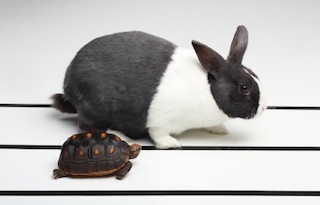 A conversation the other day got me thinking about personality and weight loss/health transformation. Do certain “types” tend to approach health changes differently? For instance, do intense personalities steer toward a cold turkey approach? Likewise, do milder characters lean toward a slow and steady style? And what does the research say? Everyone is always looking for the path that entails the least amount of pain, toil and struggle. Maybe we’re lead by intuition, or maybe we’ve had our share of personal experimentation – with its collection of successes and frustrations. For example, maybe you tried to go cold turkey once and feel like you fell flat on your face. On the other hand, maybe you tried it and it wasn’t a total disaster but was just too uncomfortable. You wanted a different process. (As long as we accept responsibility, we always get to choose our process.) The same goes for the slow and steady method. Maybe it just elicited impatience over time. Knowing ourselves is key to undertaking any health change, but how does personal idiosyncrasy merge with bigger behavioral and physiological patterns?
A conversation the other day got me thinking about personality and weight loss/health transformation. Do certain “types” tend to approach health changes differently? For instance, do intense personalities steer toward a cold turkey approach? Likewise, do milder characters lean toward a slow and steady style? And what does the research say? Everyone is always looking for the path that entails the least amount of pain, toil and struggle. Maybe we’re lead by intuition, or maybe we’ve had our share of personal experimentation – with its collection of successes and frustrations. For example, maybe you tried to go cold turkey once and feel like you fell flat on your face. On the other hand, maybe you tried it and it wasn’t a total disaster but was just too uncomfortable. You wanted a different process. (As long as we accept responsibility, we always get to choose our process.) The same goes for the slow and steady method. Maybe it just elicited impatience over time. Knowing ourselves is key to undertaking any health change, but how does personal idiosyncrasy merge with bigger behavioral and physiological patterns?
There’s a relatively scant amount of research (but plenty of expert opinion) on the subject, and it veers off in confoundingly contradictory territory. Still, the particular emphases and findings can, I think, inform our journeys when we don’t take them as absolute prescription but illuminating angles. In the end, few things in life are every 100% one way for 100% of people. We’re responsible for knowing how we tend to operate, placing that knowledge in the context of larger statistics.
The Case for Cold Turkey
It’s the proverbial ripped off band-aid, the mercilessly yanked tooth, the instantaneous jump-off-the-cliff approach. For some, it’s the ultimate set-up for defeat (or rebellion). For others, it’s simply the only way.
There’s a certain exhilaration, I think, to facing the change head-on, to feel you’re charging at it, plowing through the physiological blow back with a kind of “make my day” attitude (low carb flu be damned…). The immediate intensity can offer its own form of frenzied gratification for some people. The momentum itself can carry us.
Not everyone who goes cold turkey, of course, takes the warrior mentality. For some, they whine and whimper to the point of driving themselves and everyone around them to the brink of sanity. Nonetheless, they hold fast to their determination to make it through the rough stuff asap and come out on the other side with the worst behind them. The relief – and pride – are worth the condensed transition.
As for the research, one small but compelling study suggests that big and bold weight loss success early on (the kind you get going all-out) can serve you well in the long run. Researchers followed 262 obese women as they participated in 6-month long lifestyle programs designed in fast, moderate and slow groups and during a year’s follow-up after the conclusion of the programming. Participants in the moderate group were almost three times more likely than those in the slow group to have lost ten percent of their body weight. As for those in the fast group, they were five times more likely than the women in the moderate group to have hit that ten percent body weight lost. As a whole, those in the fast group maintained their weight just as well as those in the other groups.
It’s important to understand, however, that these participants went through a program with direct guidance in the first six months and then received follow-up support for another year. Most people who attempt to lose weight or make another significant change in their health aren’t working with that level of intervention. It’s similar to the success of well-designed detox regimens (hint: most are not well-designed or physiologically sound) as well as the reasoning behind the 21-Day Primal Blueprint Challenge. By all means, believe in the motivating power of a big weight loss/physical transformation surge. That said, the intensive/cold turkey approach perhaps works best for many/most people when it’s accompanied by as much routine and support as possible.
The Case for Baby Steps
On the other hand, you have the baby step approach, the inch at a time, wading gradually deeper into the pool style. It’s the approach that feels less scary, less all or nothing, less likely to fail. For some it offers a safe feeling of being in control and fully confident in each step. In comparison to the cliff-jumpers above, people who lean toward baby steps prefer ground under their feet. They think of it as more of an endurance event rather than a sprint and choose to pace themselves accordingly.
Creating change incrementally definitely offers the chance to make each choice your own. You might lean less on regimen and prioritize the full lifestyle picture more. Progress comes more slowly, but you might feel more confident that it’s here to stay once it does. Though you might not feel the exhilaration of the fast paced progress, you know you won’t experience the crash and burn “now what?”
Again, actual studies are few and far between, but it doesn’t keep expert opinion from falling solidly on the side of baby stepping it. Sure, research demonstrates that people who choose and implement small behavioral changes over time will achieve weight loss success, in one study more successfully than those who are given a set “didactic” regimen. That said, what’s the real crux here? Does routine and regimen help when it comes to intense efforts but hinder progress with slower approaches? There’s not really research to say either way, but I think we can come up with our own thoughts on that.
The issue with baby steps, perhaps, is balance. Ownership of choices and changes is one thing. If you go too long without progress, however, that “deep” approach might eventually work against you. Without success, motivation will almost inevitably lag.
The Bottom Line
The Primal Blueprint is a loose framework for a reason. While many basic principles are clear, not everyone needs to fall in lock step. More important is making the plan your own, and that seldom if ever happens overnight. As you begin the PB, if you’re up for blasting through the initial changes, go for it. Embrace the fast weight loss and body composition shifts you’ll see in a short amount of time.
That said, however, don’t feel intimidated by the fast and furious. Steady change when done thoughtfully will get you where you need to go. Want to up your chance of success? Research suggests the more you can dovetail changes across lifestyle areas to merge into inclusive lifestyle change, the better off you’ll be. Modestly and gradually altering one area of your health might be more beneficial than exclusively overhauling a single dimension at a time.
I’m curious about your direct experiences? What approach have you taken in the Primal transition? Have you experimented? What has worked best for you? Offer up your thoughts and anecdotes, and thanks for reading.
Order The Primal Blueprint Starter Kit and Take Control of Your Health Today!

November 13, 2013
Are Your Skin Problems an Autoimmune Issue? – Answers, Solutions, plus a New Primal Book!
 Today’s guest post is from my good friend Tara Grant, truly a budding superstar in the Primal/paleo/ancestral health movement. Tara started out as a success story (“Tons of Doctors and No Solution” – one of the most visited stories in our entire archive; and also on the pages of the
The Primal Blueprint 21-Day Total Body Transformation
), and has leveraged her Primal success (she went from 245 lbs to 159 lbs in around 18 months in ’09-’10) like few others: She’s a veteran PrimalCon presenter, has delivered numerous Primal Blueprint Transformation Seminars, and recently completed a remarkable book called
The Hidden Plague
, which details the painful and poorly understood skin condition of Hidradenitis supprativa (HS).
Today’s guest post is from my good friend Tara Grant, truly a budding superstar in the Primal/paleo/ancestral health movement. Tara started out as a success story (“Tons of Doctors and No Solution” – one of the most visited stories in our entire archive; and also on the pages of the
The Primal Blueprint 21-Day Total Body Transformation
), and has leveraged her Primal success (she went from 245 lbs to 159 lbs in around 18 months in ’09-’10) like few others: She’s a veteran PrimalCon presenter, has delivered numerous Primal Blueprint Transformation Seminars, and recently completed a remarkable book called
The Hidden Plague
, which details the painful and poorly understood skin condition of Hidradenitis supprativa (HS).
Tara has become an underground legend in the online autoimmune community for helping people solve frustrating skin conditions such as HS (and assorted other autoimmune issues) with a methodically designed diet-based protocol that identifies trigger foods and promotes natural healing of the digestive tract and immune system. Her post today might resonate with many of us who deal with mild to significant skin issues the traditional way (lotions, potions, creams, prescriptions) with less than stellar results. For example, I flipped a copy of her food restriction protocol to a friend of mine who’s suffered from psoriasis and been under medical care for 40 years…She reported immediate and dramatic improvements after following Tara’s protocol. Enjoy Tara’s post and learn more about the book below…
My Story
I have been sick for as long as I can remember—except that I didn’t actually realize I was sick until I was in my mid-thirties. Before that, my baseline notion of health was what it was, and I was basically living in acceptance as a miserable, suffering human. When I switched to a Primal Blueprint eating style in 2009, a lot of the chronic conditions I thought were “normal” suddenly vanished. I was left with a feeling of health and vitality that, frankly, I wasn’t used to. I didn’t realize that human beings could actually feel this good, or that I could actually look good like the fortunate few!
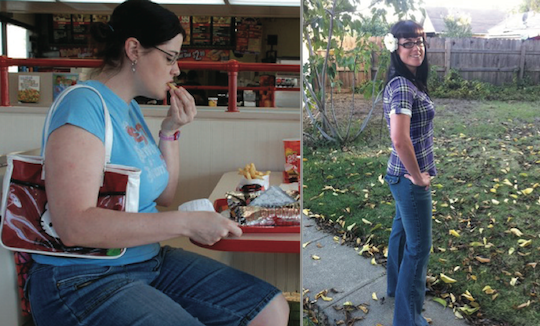
I used to have quite a lot wrong with me, including PCOS, IBS, endometriosis, massive mood swings, joint pain, and depression. As bad as those problems were, issues with my skin trumped them all and caused me considerable psychological damage. I suffered from cystic acne—both as a teenager and as an adult, long after it was supposed to have stopped. I had mild eczema, chicken skin on my upper arms, mysterious hives and rashes, and itching from head to toe. My skin would get inexplicably dry and cracked, especially on my feet and legs. I suffered from ingrown hairs in my nose, on my scalp, and anywhere I decided I wanted to shave. I was riddled with inflammation, and my skin broadcast the tale for the world to see. I felt eighty years old. I hurt. I was sick. I hated my life and I wanted to die.
Something told me that living in constant pain and misery wasn’t what nature had intended for us as a species. I knew I could get better, but I didn’t know how. Everyone around me was “sick” too—even the doctors I went to see. In an attempt to fix myself, I became a serial patient—I saw over forty doctors in four different countries when I was working for NATO. Each doctor attempted to treat my individual symptoms, as if the symptoms were the problem – instead of just…symptoms…of a bigger issue. Nothing they tried ever worked. I spent thousands of dollars on antibacterial and acne products, to no avail. I took any and all medication I was offered, hoping that the answer was in the latest pill, and being constantly disappointed. None of the forty medical doctors ever suggested a connection to diet or made any recommendations about my diet.
During this time, the worst problem I had with my skin (and this is one I never told anyone about) was a condition called Hidradenitis suppurativa, or HS for short. I suffered from HS for over 20 years, with no more than a couple months respite from the horrible pain. Doctors were stumped when I mentioned the symptoms of this condition to them. Typically, I was told I would need to make another appointment, or that they simply didn’t know what was wrong with me. Although the condition got drastically better when I started eating Primally, it didn’t fully go away. I still flared-up from time to time, for no apparent reason. I knew I was on the right track with my diet modifications, and I made it my mission to somehow solve my last and most painful lingering problem, no matter what it took.
What is Hidradenitis suppurativa?
HS manifests as painful boils, deep-seated lumps, and acne-like lesions in inverse areas of your body—that means anywhere skin touches skin. In severe cases, or when inflammation is extreme, any hair follicle on your body is fair game. In order to really bring this concept home, let’s play a thought exercise. Take the worst breakout you ever had as a teenager. Now, turn it into a boil and make it the size of a golf ball. Where shall we place it? How about your groin? Armpit? Under your breast, on your scalp, the back of your neck, or on your testicles? Sounds horrific, doesn’t it? Now, let’s add in the unfortunate fact that this boil (let’s say it’s in your groin) takes approximately two months (or longer) to go away. While it’s healing, it leaks and oozes both pus and blood, gets even more inflamed and painful, and has a huge chance of becoming infected. Forget about your sex life or that tropical holiday you had planned. You don’t want anyone to see you—or touch you—during this time. Right as the boil is starting to fully drain and heal, another one pops up right next to it, starting the whole damn cycle over again. Unfortunately, this is what people with HS deal with on a daily basis. HS is classified as one of the most painful diseases you can have—and doctors will tell you that there’s no cure. There isn’t even a standardized treatment or medication that works. Sufferers leave the doctor’s office with little to no hope that their condition will ever get better.
There are different stages to HS, and in stage one the sufferer may not even know they have an actual “disease.” They may think they just have weird ingrown hairs in their armpit or their nose, or zits on their butt. People that do go to the doctor usually leave with a diagnosis of: “Keep yourself cleaner, here are some antibiotics.” About once or twice a year, people with stage one HS will experience some sort of strange painful lump, zit or boil that will linger for a while and then mysteriously go away. They usually don’t even think to go to a doctor about it.
Until the disease progresses, that is. When HS reaches stage two and three, there’s no escaping or denying it anymore—that’s when the golf ball-sized boils come into play. This doesn’t happen without intense inflammation, which fortunately a Primal Blueprint eating, exercise, and lifestyle pattern help protect against substantially.
Why Don’t More People Know About HS?
You’ve probably never heard of HS, and I’m not surprised. Those of us that do have it often don’t like to talk about it. It’s super embarrassing, and we’ve been made to feel ashamed of ourselves. According to HS-USA, an online support group, there are upwards of 12 million people with HS in the United States alone, and a huge portion of this number are suffering in silence. That’s more people than are living with HIV and AIDS. HS isn’t an American problem, either. I’ve heard from people as far away as Finland, Thailand, India, and Australia who are afflicted, and who are struggling to find help.
Although you may not have heard of HS before, I guarantee that you know at least one person with it. They may not talk to you about it, or even know what it is that they have. Many people live with HS for years without ever seeing a doctor, or even telling anyone about it. HS is closely linked to depression, and sufferers may cut themselves off from friends and family in an attempt to isolate themselves. They may even attempt suicide.
When you’re in pain, it’s hard to sacrifice something that gives you pleasure, like food. But, truthfully, I am trying this because I’m at the end of my rope. I wake up some mornings and wish I had died in my sleep. I cross the street and wish that a bus would hit me just so I wouldn’t feel pain anymore. Constantly being told there’s no cure has made me seriously consider killing myself. I am a very motivated, productive, hardworking guy … so I want to try and work this out.
SJ – Toronto Canada
Conventional wisdom and the medical community are completely stumped as to what causes HS, and even how to treat it. Sufferers are subjected to pharmacological experiments and barbaric surgeries. These treatments invariably fail to work and sometimes the patient is left worse off than they were before they went to the doctors. Unfortunately, many doctors still believe that bacteria causes HS and they advise patients to keep themselves cleaner and to take a daily course of antibiotics. Some doctors even tell their patients to bathe in bleach.
Because HS can resemble several sexually transmitted diseases (depending on where it shows up), and sufferers are led to believe that they’re “dirty,” most people with HS are incredibly embarrassed and afraid to open up, in fear that they may be judged. They have often given up hope that their condition will ever get better—or may be in denial that there is a problem in the first place. There is incredible misinformation about HS out there, and sufferers often fall for scams in a desperate attempt to find help, or make themselves sick by using home remedies that are downright medieval.
So, the short answer is that no one knows about HS because no one talks about it, there’s no research being done (except to see how we react to different drugs), and most people aren’t even aware that there’s a problem. I suffered from HS for over 20 years, with no more than two months in between flare-ups and I never mentioned it to anyone. But guess what folks: I’ve been in remission now for over two full years. Not only that, but the disease also retreated from severe stage two to mild stage one during the three years before that—at the exact same time I went Primal. Altogether, I’ve been on the mend for five years. I was told this was impossible by the medical community, and told I had no options other than resigning myself to pain and suffering. This simply isn’t true, and I’ve decided to speak out about it. This condition needs a spokesperson, some better PR, and a lot of doctors need to get a freakin’ clue. I healed and reclaimed my health all by myself. I didn’t use any creams, or take antibiotics, or have surgery. I simply changed my diet and healed my intestinal tract, which was severely damaged on account of following a Standard American Diet for decades. Whether you’re suffering from severe stage three and confined to a bed, or you’re simply bothered by the lumps under your breasts or in your armpit, The Hidden Plague can help. Understanding the true cause of your skin problems is incredibly empowering, because you can use this information to heal yourself.
So, What’s The Solution?
We’ve all had a pimple at some point. Quite a few of us have even had acne that’s been embarrassing, or problems with ingrown hairs, zits on our scalps, or even little bumps on our upper arms. It’s easy to forget just how sick we used to be back in the SAD old days. Even though we’ve (hopefully) become fat-burning beasts, have energy for days, and look amazing in a swimsuit, I would go so far as to estimate that about 50 percent of us on a standard Primal or paleo diet still have some sort of issue with our skin. Inflammatory skin problems seem to be the last symptoms standing for many of us and they’re so friggin’ frustrating. Even when we cheat a tiny bit with food indulgences, we get hit like a freight train. Many of us chock this up to hormone imbalances, but the truth of the matter is that it’s more likely any skin condition you’re still experiencing after going Primal is autoimmune. That means you also have a leaky gut and probably have something called dysbiosis (a microbial imbalance in your digestive tract).
Here’s a shocker that you might want to sit up and pay attention to: It’s quite likely that some or many seemingly “safe” Primal-approved foods are aggravating your condition, or keeping you from fully healing.
Rarely do we connect what we eat to the state of our skin. However, once that connection is made it can be a wonderful awakening. It allows us to break free from the unproductive relationship many of us have found ourselves in with traditional dermatological and medical care; it puts the power to heal ourselves back in our own hands.
What Is the Autoimmune Paleo Protocol?
The Autoimmune Paleo Protocol, or the AIP for short, is a stricter version of the Paleo diet. Created by Robb Wolf to help heal a leaky gut (and therefore autoimmunity), the AIP removes certain foods like nightshades and eggs for a certain period of time, and then reintroduces them to see if there’s a reaction. Many people are able to heal themselves simply doing a strict AIP for 30 days, finding out what triggers them and then avoiding those foods in the future. A standard AIP works great for conditions like rheumatoid arthritis and endometriosis. However, there are still a number of us with inflammatory skin issues that don’t see complete relief with the AIP. That’s where my Skin Protocol (detailed in The Hidden Plague) comes in to play. If you experience autoimmune reactions like itching, boils, and acne that the standard AIP doesn’t take into account, you may benefit from further dietary restrictions. Unresolved issues like eczema, rashes, acne related to your period, dandruff, even headaches, can all be helped using the information in The Hidden Plague.
How Journaling Can Help
It took me three years to really nail down my triggers because I didn’t keep a food journal. I wasn’t very scientific when I first started out—but when I started seeing results I needed to be able to replicate them. The flare-ups seemed to be so random sometimes, but I knew deep down that there was a pattern. As soon as I started writing things down, that pattern became visible and I was able to connect a lot of dots. I’m hoping that by following the step-by-step protocol in The Hidden Plague you’ll be able to nail down your triggers in a couple of months.
The Primal Blueprint 90-day Journal can be really helpful in this journaling process, because it prompts you to take a big picture view of numerous diet, exercise and lifestyle variables that affect your energy level, mood, cognitive performance, physical performance, and status of health problems (such as an assortment of skin issues or autoimmune issues). Many people don’t know where to start when it comes to journaling, and thus might find motivation wavering. I strongly recommend taking a 90-day period of your life and recording all the data that you are directed to in the 90-Day Journal. If you happen to have annoying skin issues or other autoimmune issues, The Hidden Plague provides a detailed plan for how to find out what is triggering flare-ups in you and how to stop them. The book contains a complete Skin Protocol diet, as well as a guide to reintroduction after your restriction phase ends. You’ll learn what really causes inflammatory skin conditions, what a leaky gut is, how autoimmunity works, and how to put an autoimmune condition into remission. We’ve even got some autoimmune friendly basic recipes to get you started, including tomato-free pizza sauce and ketchup.
I want to leave you with the idea that you don’t have to suffer in silence, that you have other options besides the mainstream medical care protocol, and that you are obligated to take responsibility for your health. “Trusting your gut” is better than blindly following along with the many dietary and lifestyle practices that can destroy your health if you are not careful, or not lucky.
Special Limited-Time Offer
Mark here. First off, many thanks to Tara for sharing her very personal story with us today. When I first heard it myself, and then learned more about HS and the numerous clients she has helped overcome this autoimmune disease, I knew I wanted to help spread this important message – especially because it is so often misdiagnosed and misunderstood by the conventional medical community.
Today, I’m pleased to be able to officially announce the release of The Hidden Plague through Primal Blueprint Publishing. As per Mark’s Daily Apple tradition, I’ve put together a special limited-time offer to order this book direct from PrimalBlueprint.com before it goes on sale to the general public. It expires on Saturday, Nov. 30, 11:59 pm PST.
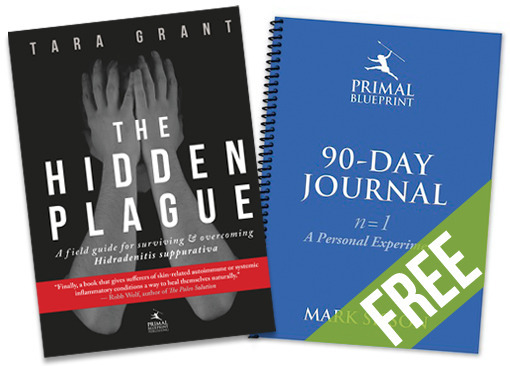
Order a copy of The Hidden Plague today and get a FREE copy of The Primal Blueprint 90-Day Journal (retail value $22.95).
The 90-Day Journal is the perfect companion to Tara’s new book. It will help you track, identify, and eliminate trigger foods and behaviors, so you can begin to heal your digestive tract and immune system and end your suffering once and for all.
If you have struggled with mystery skin problems including autoimmune reactions like itching, boils, rashes and acne this book was written for you. As Tara indicated, this could be a sign that you have leaky gut and a microbial imbalance in your digestive tract, and this book can help you resolve those issues. So order your copy today and take advantage of this special free book offer. And if you know someone who you think could benefit from this book please don’t hesitate to pass this article on to them. It could be life-changing.
Read an excerpt of The Hidden Plague
Many thanks to everyone that purchases one or more copies of The Hidden Plague over the next couple weeks. Tara Grant and the entire Primal Blueprint Publishing team and I appreciate your support and hope that this new book will touch your lives just as Mark’s Daily Apple and previous Primal Blueprint books may have in the past. Grok on!
Fine Print:
Unlike previous retail channel promotions, this one is simple: You order the book directly from PrimalBlueprint.com and we send you the free bonus item directly with your book order. No worries, no hassles!
This special bonus offer ends at 11:59 pm, Nov. 30, 2013 (PST).
Only orders placed on PrimalBlueprint.com will receive the bonuses.
The Hidden Plague is not yet available on Amazon.com or at other retail locations.
Both domestic (U.S.) and international orders are eligible for the bonuses.
Order Your Copy of The Hidden Plague Today!

November 12, 2013
How to Engineer a Successful Day of Sunbathing
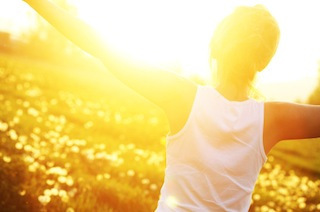 Last week, I walked you through the typical day of someone pulling out all the stops in the pursuit of a perfect night’s sleep. Today, I’m going to show you how to optimize the pursuit of another vital factor in our health: sun exposure. Unlike sleep, too much sunlight can hurt you if given enough time and the improper context. As much as we like to chuckle at the people scurrying for the shadows at the first hint of UV, and those that slather on 100 SPF sunblock at 5 PM, taking certain precautions and getting correct dosage is crucial. This is something I have to be particularly mindful of here in sunny southern California.
Last week, I walked you through the typical day of someone pulling out all the stops in the pursuit of a perfect night’s sleep. Today, I’m going to show you how to optimize the pursuit of another vital factor in our health: sun exposure. Unlike sleep, too much sunlight can hurt you if given enough time and the improper context. As much as we like to chuckle at the people scurrying for the shadows at the first hint of UV, and those that slather on 100 SPF sunblock at 5 PM, taking certain precautions and getting correct dosage is crucial. This is something I have to be particularly mindful of here in sunny southern California.
When we sunbathe, we’re trying to do several things at once. We want the vitamin D and all the other sunlight-related metabolites our bodies produce in response to UV-rays. Our eyes want the brilliant natural light to get our circadian rhythms aligned. The melanin-deficient among us often want to obtain and maintain a nice healthy tan. And we want to accomplish all these goals without damaging our skin and our DNA. This is crucial, because, except for white-skinned youngsters who don’t use sunscreen in the summer, most people are simply not getting enough vitamin D (via sunlight or supplementation).
So, what does your day look like?
You awake after the greatest sleep of your life, having gone to bed at the appropriate time. This is essential for successful, safe sunbathing, since our ability to repair UV-derived damage depends on a well-functioning circadian rhythm. If you didn’t sleep well or are running on a chronic sleep deficit, you may want to hold off on the sunbathing until you get your sleep in order as your skin won’t recover as well.
If you eat breakfast, you lay out an impressive spread of smoked wild salmon (or krill smoothie) and pastured eggs in butter. The salmon has astaxanthin, a photoprotective compound, as well as EPA and DHA, which have been linked to UV-protection. Omega-6 levels were linked to worse UV-protection in that same study, and pastured eggs have a better omega-3:omega-6 ratio than normal eggs. The butter is a good source of saturated fat, which offers more protection against sun damage than polyunsaturated fat.
You enjoy a large cup of coffee or a mug of good green tea (or both). Consumption of both coffee and green tea have been shown to increase UV-protection, probably due to both the caffeine content and the phytochemicals present in tea and coffee. Throw some pastured cream in that coffee for good measure if you have it.
You consider going out to sunbathe at midmorning when the sun is aslant, because as “everyone knows” the safest times to sunbathe are in the morning and late afternoon – anytime you can avoid the mighty and terrible midday sun. Luckily, you catch yourself and remember that UVA is highest in the morning and late afternoon, while UVB is lowest (nonexistent, even). Why is this a problem?
UVA penetrates skin rather deeply, passes through clouds, window panes, water, and ozone, and has been implicated in melanoma (the most serious and deadly kind of skin cancer) and DNA damage (PDF). And it doesn’t even make vitamin D.
Not only does UVA provide no vitamin D, it actually breaks down vitamin D by binding to the vitamin D receptor. Combined with UVB exposure, this is probably a mechanism for vitamin D regulation, but without the UVB, you’re just losing vitamin D.
UVA does not readily burn you, so you have no indication if you’re getting too much like you do with UVB.
We’re meant to get a balance of UVA and UVB together.
If you only have the morning (or late afternoon) available, go out and get sun anyway; some is better than none. The light exposure is important for your circadian rhythm, too.
For lunch, you enjoy a Big Ass Salad with a dressing made from something rich in monounsaturated fats, like olive oil or macadamia nut oil. MUFAs aren’t just oxidatively stable. They (or at least oleic acid) are also a precursor to oleamide, a sleep-inducing endogenous compound that may offer protection against the metastasis of melanoma cells. All the phytonutrients from the vegetables can’t hurt, either.
You grab that nice red you’ve been holding onto and slip it into your beach bag. Nothing like a glass of zin as you bask in the sun, plus the proanthocyanidines from grape seeds (which show up in red wine) offer photoprotection.
You nearly forget to pack a bar of really good, really dark chocolate with 85% cacao. Dark chocolate is rich in stable saturated fat while providing flavanols that help against UV damage. Note that the best quality chocolate with the highest cacao content will have the most protective flavanols.
It’s now right around noon, and the midday sun is directly overhead, your shadow nonexistent. It’s time to get some sun. UVB exposure, and thus vitamin D production, is at its peak (PDF). UVB burns, but it also tans (thus giving warning), and it doesn’t penetrate deep enough into the epidermis to trigger melanoma. At noon, you’re getting both UVB and UVA. UVB counteracts the UVA damage; UVA keeps the vitamin D synthesis from getting out of hand. If we upset the balance and get too much UVA without enough UVB, melanoma may result.
Now, before you go out, let’s figure how much time you need to spend. How much sun time you require for optimal vitamin D production depends on a few variables.
If you’re young, lean, and light-skinned, ten to fifteen minutes should be enough for vitamin D.
If you’re elderly, your skin probably doesn’t synthesize as much vitamin D in response to sunlight. You may need more time.
If you’re dark skinned, you need more time in the sun to make vitamin D. Those living in northern (or far southern) climes may need to supplement vitamin D to meet their requirements, as their ancestors likely evolved in warmer, more tropical climates with more intense sunlight.
If you’re obese, you won’t make and absorb as much vitamin D in response to UVB.
According to the Vitamin D council (link above), these groups may need about three times more sun exposure to hit regular vitamin D levels.
Information and plan in hand, you take a furtive glance around and remove as many articles of clothing as possible. Remove all your clothes if possible to increase exposure. Men, open your legs, prop a leg up on a chair while gazing off into the distance, or practice handstand splits – legend has it that exposing your testicles to the midday sun can actually increase testosterone levels. Maybe it’s the UV-B increasing localized vitamin D biosynthesis increasing testosterone production. Or maybe it’s the freedom, the sway, the breeze. Either way, I know I saw a link to the research previously. I’ll try to dig it up.
You lie down on the ground to optimize UVB exposure. Remember, part of the reason why we took over this world is our obligate bipedalism, which allowed us to move around without receiving the full brunt of the harsh African sun (it also explains why we evolved the fedora).
You stay in the sun until it stops feeling good. When the warmth turns to heat, you remove yourself. When basking turns to cringing, you get out of there or put some clothes on. When you can feel your skin burning, you’re too late. You won’t die or get cancer tomorrow because of it, but next time, get out before you reach that point. That burns are unhealthy is one of the things CW gets right.
If you want to stay out in the sun, put on some clothing or use a quality broad-spectrum sunblock (that blocks both UVA and UVB). Browse this post for non-toxic, full-spectrum options.
If you’re still around when late afternoon hits, you hightail it out of there or cover up. As the sun dips toward the horizon, UVB is waning and UVA remains. You don’t need any more UVA. U’VAd-enough! Get it? (Sorry.)
For dinner, you eat some Primal chili, or something else with cooked tomatoes, canned tomatoes, or tomato paste. The lycopene (which is far higher in cooked tomato products) will offer photoprotection. Insider tip: add a bar of dark chocolate to the chili just before serving for improved taste and UV protection.
You’re sleepy, in a good way – sunbathing’ll do that to you – and you find yourself nodding off a bit earlier than usual. With more good weather forecast for tomorrow and a beach barbecue planned, you turn in for the night to ensure another night of excellent sleep and even better photoprotection.
As there are genetic components to sun resistance, this isn’t foolproof. But clearly, getting some sun is better than avoiding it altogether. If you’re going to get some sun, you want to stack the deck in your favor, and you could do a whole lot worse than a day like this.
Thanks for reading, folks. What did I miss?
Get Your Omega-3s: Order Two Bottles of Primal Blueprint Fish Oil Capsules and Get An Additional Bottle Absolutely FREE

November 11, 2013
Dear Mark: Resistant Starch, Zinc Deficiency, and Something New
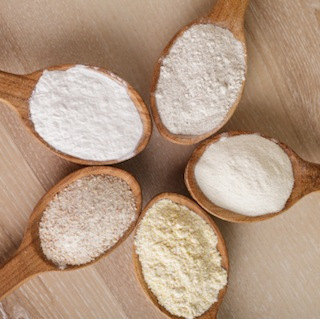 For today’s edition of Dear Mark, we’ve got a three-parter. In the first section, I discuss the extremely hot (and then allowed to cool off) topic of resistant starch, explaining who might benefit from it, who might not, and where you can find further information on the subject. Second, I briefly go over how a zinc deficiency might arise and how you can address it on a Primal eating plan. The third section is bit of a surprise, featuring a very special guest writer. Since this is text and you guys can just skip ahead to see who it is, there’s admittedly very little suspense. But still. It’s a surprise that I think you’ll enjoy and appreciate.
For today’s edition of Dear Mark, we’ve got a three-parter. In the first section, I discuss the extremely hot (and then allowed to cool off) topic of resistant starch, explaining who might benefit from it, who might not, and where you can find further information on the subject. Second, I briefly go over how a zinc deficiency might arise and how you can address it on a Primal eating plan. The third section is bit of a surprise, featuring a very special guest writer. Since this is text and you guys can just skip ahead to see who it is, there’s admittedly very little suspense. But still. It’s a surprise that I think you’ll enjoy and appreciate.
Let’s go:
What about so-called resistant starch, that is, starch that passes undigested through the stomach but arrives in the colon? There’s some emerging evidence that the good bacteria that live in the colon need to feed on this starch in order to thrive. In other words, if everything is processed by the stomach and small intestine, the good “microbiome” is underfed, and the bad guys can multiply. An unhealthy microbiome may be tied to all sorts of auto-immune diseases. Do we need some resistant starch in our diets?
Resistant starch has really been making waves in the Primal health community. Lots of talk in the MDA forums and elsewhere.
So what’s the deal?
Resistant starch is a starch that resists digestion by regular digestive enzymes, passing through to the colon for fermentation by gut flora. In a post way back in the day, I addressed resistant starch and lumped it in with other prebiotic fibers like inulin, with the reasoning being that while it was certainly helpful and important, it was not some essential, magical nutrient. It seems I underestimated it. Resistant starch offers some interesting properties unique among other prebiotics.
It promotes greater butyrate production than other prebiotics. Butyrate is the short chain fatty acid produced by gut flora that has some helpful effects on colon health (it’s actually the primary energy source for our colonic cells). Greater production of butyrate may explain the superior colonic health (and resistance to colon cancer) of non-industrialized cultures, for example. When we eat prebiotics, we’re often interested in the butyrate production.
It improves insulin sensitivity, even in people with metabolic syndrome.
It lowers postprandial insulin and blood glucose levels.
Remember that starch post from a couple week’s back where I compared the fiber content of the kind of wild tubers our ancestors would have encountered to modern cultivated tubers? Much of the “fibrous material” would have been resistant starch, a highly efficient, durable method of energy storage for a plant’s underground storage organ. In the wild, where a plant isn’t protected from pests by agricultural chemicals or physical barriers, resistant starch makes sense. And so when we ate these tubers, we’d get a nice dose of resistant starch, particularly if we ate them raw or undercooked (cooking degrades the majority of resistant starch into regular old highly digestible starch).
Before agriculture, our ancestors obtained resistant starch and other fermentable fibers by eating a diversity of wild plant foods, bulbs, corms, tubers, cattails, cactuses, and medicinal barks – foods that by and large are not available to us nowadays (and if they were, they wouldn’t be very desirable or delicious). According to some estimates, they consumed up to 135 grams of fermentable fiber a day, and their gut flora would have reflected that. Nowadays, the most common sources of resistant starch in the modern diet (PDF) include various legumes, raw oats, and even certain types of bread that’s been frozen for 30 days. Raw potatoes, green bananas, and raw plantains are also quite high in resistant starch, but few people are eating them in their raw state. It’s much more delicious to cook them. We also have reliable means to cook our foods well enough to break down most of the resistant starch, like microwaves, ovens, and stoves. So, the result is many people following a Primal lifestyle – avoiding legumes and grains while cooking and reheating their starches – are also missing out on an important source of prebiotics and, perhaps, optimal gut health.
There’s a quandary, then. Resistant starch seems to promote ancestral-esque gut health and floral composition. How do we get resistant starch without foraging for wild foods or eating ungodly amounts of legumes, raw grains, and previously-frozen bread (thus incurring many of the negative aspects of these foods, like gut-damaging lectins, phytic acid, and/or gluten) or raw plantains and potatoes?
Unmodified, raw potato starch is probably the easiest way to get resistant starch, since each tablespoon contains about 8 grams of RS. Richard Nikoley has spearheaded the promotion of resistant starch via unmodified potato starch as a way to approximate or emulate the ancestral microbiome over at his blog. He’s been covering the benefits and relaying lots of anecdotes from readers who’ve seen great improvements in sleep quality and blood sugar control, even when diabetic or while remaining in ketosis). He even came up with a way to make mashed potatoes that don’t spike your glucose. Interesting, compelling stuff.
I think it’s worth trying. Potato starch is only about $4 or $5 a bag (less if you order in bulk on Amazon), mixes well in water or smoothies without much of a taste. Start with a teaspoon or two and work your way up to as many as four tablespoons. Expect flatulence as your gut flora acclimatize to the influx of this food.
Anyone with digestive issues, particularly FODMAP intolerance or IBS, may want to exercise caution as fermentable carbohydrates often irritate or exacerbate those issues. On the other hand, there’s preliminary (and mostly theoretical, as it hasn’t been directly tested) evidence that resistant starch may actually treat small intestinal bacterial overgrowth by “flushing” the pathogenic bacteria out in the feces. Adding resistant starch to the rehydration formula given to cholera patients, for example, is an effective treatment because the cholera bacteria attach themselves to the starch granules almost immediately.
Anyone else try this? What have they noticed?
I attended a nutrition study course over the weekend and several vitamin deficiencies were discussed. Each delegate was also given a vial with a stopper of zinc solution to test ourselves for deficiency. I basically could taste nothing and despite being on an ancestral diet for over a year now, am apparently zinc deficient, which is worrying. I just wondered whether the zinc taste test had any merit? On a side note, this has since led me to investigate the whole nuts/phytic acid binding minerals issue and despite soaking and drying my nuts, I consume WAY too many which may be the cause of this deficiency if it indeed exists. Thanks for your attention to this matter.
Michelle
The zinc test definitely has merit. In a study of pregnant women (whose zinc levels tend to drop as the pregnancy progresses), the accuracy of the zinc taste test ranged between 70-100%. Overall, the results of the test correlated strongly with zinc status. I see no indication that the test is only valid in pregnant women; anyone who’s deficient enough should qualify.
The nuts could be a problem. Low to moderate amounts (an ounce or two a day) aren’t an issue in the context of a nutritious Primal way of eating, but eating “way too many” will eventually impact nutrient absorption via phytate binding because, unfortunately, zinc is susceptible to phytate.
Meanwhile, adding phytase (which degrades phytate) to zinc-rich foods increases the absorption of zinc. It’s pretty clear that excessive phytate is a problem. How much phytate? I don’t have a hard figure for that, but being deficient in zinc despite eating Primally is a good indicator.
So, what should you do?
Eat enough selenium. It’s responsible for regulating the delivery of zinc to zinc enzymes throughout the body for proper zinc metabolism. Seafood like wild salmon is a good source of selenium. Eggs, too. And the very best of all is the Brazil nut. One or two Brazil nuts should get you to the RDA for selenium without giving too large a dose of phytate.
Make sure you’re actually eating enough zinc, of course. Oysters, red meat (beef, lamb, bison), and scallops are some of the richest sources.
Limit sources of phytate. Stick to the ounce or two of nuts per day, not however many you were eating previously. Consider subbing in some macadamias, which are among the lowest in phytates, and keep soaking the nuts you do consume (not mac nuts, though).
When you do eat phytate-rich foods, give yourself a couple hours in either direction before eating zinc-rich foods. This shouldn’t be too tough, since nuts are snacks more than meal components. It does mean that your oyster sliders on almond meal bread might not be a good option, sadly.
Eat zinc with animal protein. Studies show that animal protein can counteract the inhibitory effects of phytic acid on zinc absorption (PDF). Luckily, zinc usually comes with animal protein already attached. Handy!
Account for excessive sweating. Sweating is a good thing, usually, because it indicates vigorous physical activity, but it also depletes zinc. You may need to account for sweating by eating more zinc.
Supplement. In my view, Krebs cycle intermediaries (citrate, fumarate, succinate, etc.) are going to be your best bet for zinc. This is a good multimineral, which includes zinc.
Now for the surprise…
I get a lot of questions from women, and for the most part they’re very general, straightforward, and applicable to men, too. But there are times when a uniquely female perspective (that I simply cannot provide) would come in handy. Since I frequently bug Carrie for advice on this question or that one, I figured why not have her contribute directly to the blog and answer reader questions? She’s already done reader question roundups, discussed cellulite, and talked hot flashes in the past and she has a level of expertise on some topics that I don’t. In addition to being smart, beautiful, fearless, and kind, Carrie has a Master’s degree in Spiritual Psychology from the University of Santa Monica and serves as a group leader at intensive weekend spiritual psychology retreats on a monthly basis. She has participated in retreats in Los Angeles, and as far away as Norway. Carrie is hard at work on her long-awaited book, Primal Woman, which is due to be published in the fall of 2014.
Without further ado, let me introduce Carrie.
Mark, I really wish you would’ve addressed women’s cycles and necessary starch for menstruation. So many women lose their cycles only eating berries and salads. I know I did. Add back in a sweet potato, some bananas, and yes even some white potatoes and white rice. BAM! Flow city.
Carrie here. I’m not Mark but I can handle this question.
First off, thanks for your question.
Personally, I never really had this issue, even though I’ve always been pretty active, because I always made sure to eat enough food. Not too much, not too little, just enough to keep me full, help me recover, and maintain my hormone levels. The only time I ever had any issues with my cycle was when I was on a strict low-fat, “heart healthy” diet full of whole grains and other starchy carbohydrates while doing tons of cardio. Of course, I wasn’t really Primal until menopause, so I can’t really say that it wouldn’t have happened if I’d been eating this way back then. That said, the research shows that the biggest variable for regular menstruation is sufficient calorie intake. Not sufficient potatoes, rice, or bananas. Not carbs. Calories. You need them if you want to maintain a normal cycle. Your body needs to know that you’ve got energy coming in before it decides you’re ready to conceive.
Study after study shows that dieting can have a negative effect on the menstrual cycle. Let’s go through some of the research.
Like here, a 1000 calorie high-carb diet caused menstrual irregularities. Women who lost the most weight (had the biggest energy deficit, in other words) had the most irregularities. All that starch wasn’t enough to overcome a super low calorie intake.
Or here, where a vegetarian diet caused 7 of 9 women to stop ovulating, while just 2 out of 9 women in the non-vegetarian group did. Both groups lost the same amount of weight (though they don’t give a calorie count), so it was something about the vegetarian diet, not just the energy balance.
Another study showed that an 800 calorie vegetarian diet disrupts menstruation. In fact, vegetarianism seems to be especially linked to menstrual cycle disturbances (although not so much in healthy, weight-stable vegetarian women eating adequate amounts of nutrient-dense food).
They’ve even found that something called a “drive for thinness” (which I’d never heard of) is strongly associated with disrupted cycles because it leads to huge energy deficits – too much exercise and not enough food.
See the common thread? Low calorie intake. The literature is rife with examples of young, healthy women losing their period after going on a low-calorie diet, whether high-carb or not. And that calorie requirement goes up the more you exercise, which is why the “female athlete triad” – excessive energy imbalance, loss of period, and bone weakening – is a common affliction.
That’s what jumps out at me when people talk about adding in sweet potatoes to jump start their cycle: they’re adding calories to their diet. They’re not substituting potatoes for something else. They’re adding it to whatever else they were eating, resulting in a net increase in calories, and that’s fixing the issue.
If carbs are the only way you can add enough calories to your diet to restart your cycle, then go for it. But it’s not a quality inherent to the carbs. It’s just the energy they provide. The calories. I hope this helps and I will also share about some other self-honoring choices I made during my cycle that I will post in a future column.
Keep the questions coming, folks. Carrie’s agreed to chime in every Monday, so send along any questions you might have for her, too. Thanks for reading!
Order The Primal Blueprint Starter Kit and Take Control of Your Health Today!

November 10, 2013
Weekend Link Love
 We’ve got another Primal Blueprint Transformation Seminar date lined up. Mike DiLandro will holding a 2 1/2 hour presentation in Huntington, NY on Saturday, January 18. You can learn all about the seminar and get your tickets here.
We’ve got another Primal Blueprint Transformation Seminar date lined up. Mike DiLandro will holding a 2 1/2 hour presentation in Huntington, NY on Saturday, January 18. You can learn all about the seminar and get your tickets here.
Research of the Week
Next time your baby is sick and you can’t sleep from worrying, know that this is a necessary byproduct of an infant immune system purposefully weakened in order to let good gut flora flourish. It’ll pay off in the long run, parents.
They’ve just discovered an extra ligament on the anterior portion of the human knee previously unbeknownst to scientists (except for a 19th century French surgeon who postulated its existence).
Interesting Blog Posts
Here are eight ways to run yourself into the ground (in a good way) using sprints. Exercise caution; these are some serious workouts.
Our kids are missing out on play en masse, and it’s destroying their (and our) creativity, inventiveness, and ability (and desire) to learn.
Media, Schmedia
Are humans natural polymaths? If so, maybe some of that play mentioned in the last article would help us realize our polymathic heritage.
I’m no trans-fat fan, but I believe this move by the FDA sets a dangerous precedent for other vilified nutrients.
Everything Else
This is a cool infographic about the health effects of grains to send around.
Mexican coke is no longer a health tonic: they’re switching out the cane sugar for high fructose corn syrup.
People are attaching electrodes to their heads, running currents through their brains, and getting marked and measurable benefits to their cognition, depression, and cravings.
Recipe Corner
Man, does this look good: slow roasted lamb ribs with jalapeño mint sauce.
Haul out that beef tongue taking up space in the freezer, hook up the slow cooker, get your other ingredients together, and make some slow cooked beef tongue.
Time Capsule
One year ago (Nov 10 – Nov 16)
Do We Need Rites of Passage? – Are formal rites of passage into adulthood (or some other stage of life) an integral aspect of ancestral health that we’re missing out on to our ultimate detriment?
7 Ways You Might Be Inadvertently Sabotaging a Good Night’s Sleep – Sleep is pretty important, so don’t do these things that impede it.
Comment of the Week
Exactly.
To clear up any confusion, the point of my response was that if you’re losing muscle, you’re walking too much. Anytime you’re using walking as your only exercise and you’re sitting in a large chronic caloric deficit (the guy was down 7k calories a week), you’re going to burn lean mass.
Otherwise, walk all you want.
- Just in case anyone was considering hanging up their Vibrams for good.
Get Your Omega-3s: Order Two Bottles of Primal Blueprint Fish Oil Capsules and Get An Additional Bottle Absolutely FREE

November 9, 2013
Cuban Picadillo
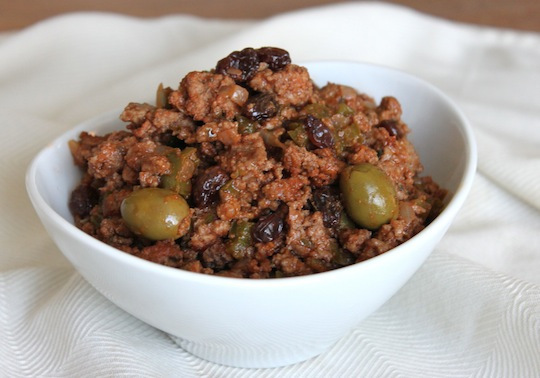 Cuban Picadillo is basically a sloppy joe without the bun. But picadillo has a little more pizzazz, thanks to the sweet and piquant flavor combination of raisins and olives simmered with ground beef and tomato sauce. Picadillo is home cooked comfort food, the type of easy weeknight meal that both kids and adults love.
Cuban Picadillo is basically a sloppy joe without the bun. But picadillo has a little more pizzazz, thanks to the sweet and piquant flavor combination of raisins and olives simmered with ground beef and tomato sauce. Picadillo is home cooked comfort food, the type of easy weeknight meal that both kids and adults love.
Like Filipino Kaldereta, the ingredients in Cuban Picadillo are a reflection of its history. Peppers, tomatoes and olives can be traced back to Spanish colonization. The blending of sweet and acidic ingredients is also a big part of Caribbean cuisine. Traditionally served over rice and beans (and sometimes, plantains) Primal Picadillo can be served over cauliflower rice or simply heaped in a bowl with nothing else. It’s also pretty great next to eggs for breakfast.
Is it entirely necessary to add raisins and olives to this dish when it’s still really delicious without them? No. But embracing new flavors and cuisines keeps things interesting at the table. You can make sloppy joes one week and picadillo the next. Same easy meal, two deliciously different flavors.
Servings: 4
Time in the Kitchen: 1 hour
Ingredients:
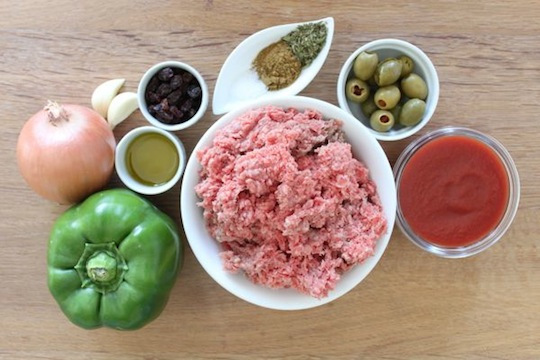
2 tablespoons olive oil (30 ml)
1 onion, finely chopped
1 green bell pepper, finely chopped
2 garlic cloves, finely chopped
1 1/2 pounds ground beef (680 g)
1 teaspoon dried oregano (5 ml)
1 teaspoon ground cumin (5 ml)
8 ounces tomato sauce (240 ml)
1/2 cup pitted green olives (75 g)
2 tablespoons raisins (30 ml)
Instructions:
Over medium-high heat sauté the onion and green pepper in olive oil until soft, about 8 minutes.
Add the garlic and the ground beef. Season the beef with salt and pepper, oregano and cumin.
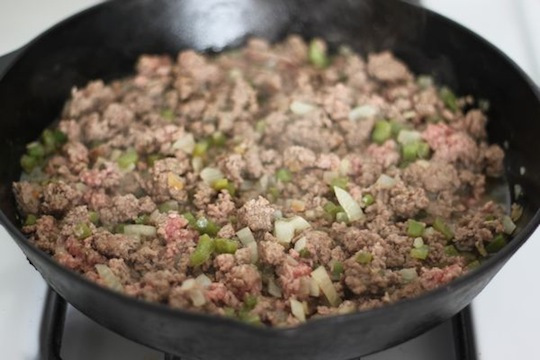
When the meat is browned but still a bit pink in the middle, add tomato sauce. Simmer 20 minutes over medium heat, stirring occasionally.
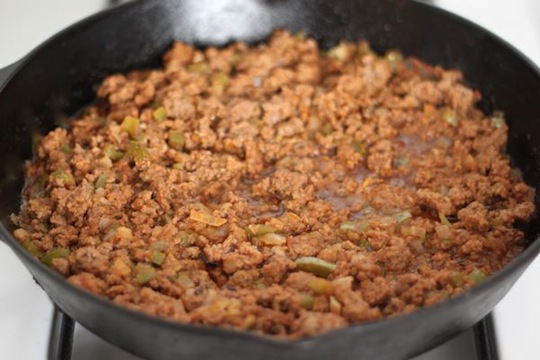
Add the olives and raisins and simmer 10 minutes more. Serve.

Not Sure What to Eat? Get the Primal Blueprint Meal Plan for Shopping Lists and Recipes Delivered Directly to Your Inbox Each Week

November 8, 2013
Everything Has Changed 180 Degrees: A Daughter’s Telling of Her Father’s Primal Journey
It’s Friday, everyone! And that means another Primal Blueprint Real Life Story from a Mark’s Daily Apple reader. If you have your own success story and would like to share it with me and the Mark’s Daily Apple community please contact me here. I’ll continue to publish these each Friday as long as they keep coming in. Thank you for reading!
 About three and a half years ago, I was introduced to the concept of paleo by a local CrossFit gym that I was attending. At that point in my life, I had some significant health challenges and also had a hard time maintaining a healthy body composition. I was ready to ditch the conventional wisdom of eat less/exercise more and try something different! I began searching the internet for anything I could find on paleo eating, and soon came across Mark’s Daily Apple. The Primal Blueprint 101 page was an invaluable resource as I was learning about Primal eating. The Friday Success Stories were an unending source of motivation and inspiration. In fact, I sat down one day and read every single success story that was ever published. At that time there were 4 years’ worth to catch up on! When I was done, I still wanted to read more. To this day, any time I have a question about anything health, fitness, or nutrition related, my first step is always to go to Mark’s Daily Apple and search on my topic. My questions are almost always answered.
About three and a half years ago, I was introduced to the concept of paleo by a local CrossFit gym that I was attending. At that point in my life, I had some significant health challenges and also had a hard time maintaining a healthy body composition. I was ready to ditch the conventional wisdom of eat less/exercise more and try something different! I began searching the internet for anything I could find on paleo eating, and soon came across Mark’s Daily Apple. The Primal Blueprint 101 page was an invaluable resource as I was learning about Primal eating. The Friday Success Stories were an unending source of motivation and inspiration. In fact, I sat down one day and read every single success story that was ever published. At that time there were 4 years’ worth to catch up on! When I was done, I still wanted to read more. To this day, any time I have a question about anything health, fitness, or nutrition related, my first step is always to go to Mark’s Daily Apple and search on my topic. My questions are almost always answered.
Six months into my journey, I had seen some fantastic results in my health, body composition, and overall well-being, and my mom wanted to know what I had been doing. She told me that she didn’t really care to understand the science or the “why” behind it all, she just wanted to know what to do. So I sat down with her one day and explained the Primal Blueprint basics. She implemented the nutritional changes immediately, and saw immediate results! Since then, she has faithfully followed the Primal principles and continues to see improvements in her health. After losing around 45 pounds, she felt good enough to begin exercising with me and now we work out together three days a week!
There’s so much more to my success story and to my mom’s as well, but I’m actually writing you today to tell you about my dad, Paul. You see, my dad was very reluctant to jump on board with this new way of eating, even though his wife and daughter were totally committed. When my mom got on board in November of 2011, my dad was 57 years old and he sure did love his breads, spaghetti, lasagna, chips and crackers, ice cream, and the occasional beer. He ate a typical S.A.D. (Standard American Diet) and tried to watch the red meats and fats due to conventional wisdom.
My dad used to tell stories of sneaking off to the woods for a few days at a time when he was a kid (when you’ve got 13 brothers and sisters, you could disappear and not be missed for a while!) and taking with him loaves of wonder bread and bunches of bananas for food. Or the days when he’d go surfing all day with his friends, and in the morning they would bury a giant jar of peanut butter in the sand so that it would be nice and melted by the time they got out of the water and needed some nourishment. He even used to pay his sisters to make dozens and dozens of oatmeal raisin cookies and hide them in plastic bags under his pillow, and he would devour them before going to sleep at night. We’d hear stories of the early years of my parents’ marriage, when dad would put down two giant, heaping plates of spaghetti and meatballs, with bread on the side. You see, my dad was always incredibly active when he was younger, whether it was playing in the woods as a child, surfing all day as a teenager, or pouring concrete and laying brick as a young adult. Check out these pictures of him in the early 1980s!!

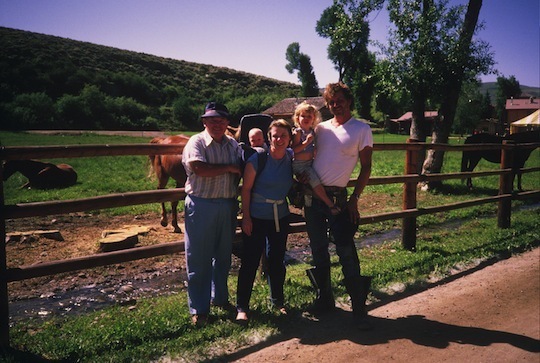
Over the years, my dad continued to work incredibly hard in physically demanding jobs – mostly pouring concrete, doing stone work, building pool decks, and laying brick. His activity levels kept him trim and fit even though he was eating a S.A.D. diet, and lots of it! But over time he began to experience some health challenges… he had surgery on both of his knees in his 30s, major surgery to fuse a metal plate to a ruptured disk in his spine, and even more surgery to fix torn rotator cuffs in both shoulders. He also had to have carpal tunnel surgery TWICE, because the first time didn’t fix the problem. For being as active as he was, it is obvious to us now that his inflammatory diet led to a lot of issues that could have been avoided. These are just some of the major health challenges that my dad was beginning to develop. After each surgery, he bounced back remarkably well and was able to continue working hard physically, although doctors did place some limitations on what he could do.
An opportunity came up at one point for him to get away from the physically demanding construction work and begin traveling around the country cleaning screens in movie theaters. He and his partner traveled for days or even weeks at a time, driving a pickup truck, living on the road, staying in hotels, and eating in restaurants all along the way. With the decrease in physical activity that this caused, along with fewer home-cooked meals and an increase in restaurant and fast foods, my dad’s weight began to creep up consistently. Along with the weight gain came struggles with high cholesterol and high blood pressure. Over the years, he put on at least 65 pounds of unnecessary weight – most of it in his abdominal region, which we all know is a BIG health concern. When he was home, he was still picking up side jobs in construction and working hard around the house, but this wasn’t enough to combat the poor eating habits and sedentary lifestyle on the road. I was in college at this time, and I began to get very concerned about my dad. I could see his expanding belly and watched him go through all of those surgeries. I made it my goal to return home after college and find a way to help my parents regain their health. Thank goodness I discovered the paleo/Primal lifestyle and could actually help them by the time I got back home! My dad would tell you that he started to get alarmed about his health and weight at this point, too.
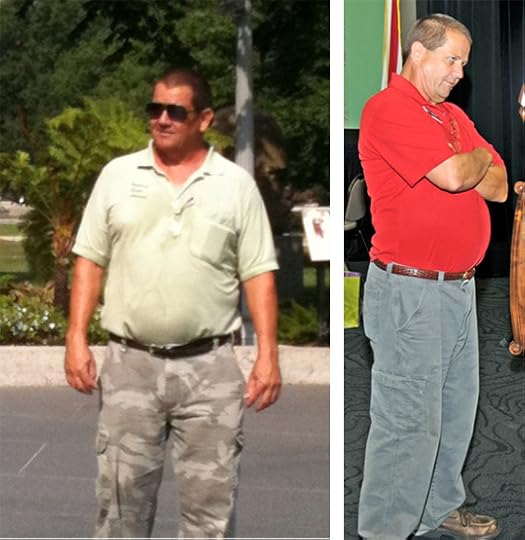
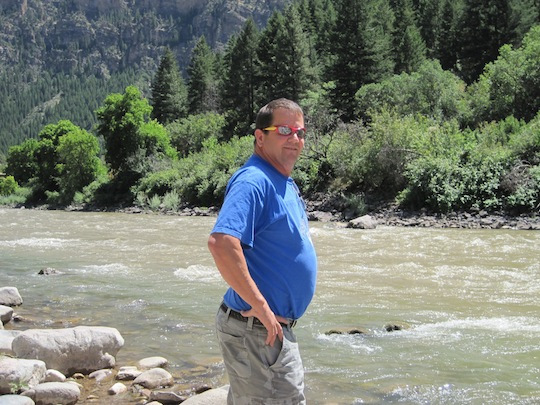
After helping my mom change her eating habits and lose weight, we both knew that my dad really, really needed to change his eating habits in order to see his weight come down and his health improve. His doctor was insistent on putting him on blood pressure medication and on cholesterol medication, which he fought vehemently. When my dad challenged his doctor on the idea of being on medication for the rest of his life, the doctor looked at him and said, “Paul, almost EVERYONE is on some type of medication or another. It’s normal!” My dad could not believe his ears. His doctor essentially left him with no hope of ever getting better on his own.
Despite these major warning signs and even after seeing my mom’s remarkable weight loss (simply by changing her eating habits to the Primal Blueprint methodology), he was extremely reluctant to make the switch to a Primal way of eating – at first. Being a man of faith, one of the biggest challenges he had was with ditching grains! He would tell us over and over that wheat and other grains were talked about in the Bible… so why wouldn’t they be good for us? Why should we have to eliminate them? The Definitive Guide to Grains helped me answer all of his questions, and in January of 2012 he began to eliminate grains, starches, and sugars from his diet, while increasing the quality of his proteins and adding in healthy fats like coconut and olive oil, avocado, and some nuts and seeds. He started eating a Big Ass Salad (thanks, Mark!) every day for lunch, and often for dinner, too. Once my dad cleaned up his nutrition, the weight started coming off immediately. Then once he started to look and feel better, he became SO determined to embrace this new lifestyle that he shocked us with his commitment and dedication! Now, he is more outspoken than any of us regarding this new way of life. Here are some numbers to show you how he has improved:
Until his mid-40’s, my dad used to weight a lean and strong 175 lbs. (Except for a brief stint while working at McDonald’s at age 22 – then he weighed 185 lbs.)
BEFORE: (approx. 2010-2011)
Weight – 238 lbs
Pants Size – 42”
Shirt Size – 2XL
Blood Pressure – 176/90
AFTER: (now)
Weight – 197 lbs
Pants Size – 34”
Shirt Size – XL
Blood Pressure – 135/70 (still fluctuates some)
Cholesterol:
2001 – HDL 49, LDL 126, Triglycerides 94
2008 – HDL 48, LDL 154, Triglycerides 98
2009 – HDL 45, LDL 129, Triglycerides 163
2013 – HDL 61, LDL 150, Triglycerides 64
Now when he travels, he tries to make his trips shorter and he brings nearly all of his food with him. Egg/meat/cheese “sandwiches” (no bread) wrapped up in foil, “spicy nuts” adapted from Mark’s recipe, almond flour muffins and banana/coconut flour muffins, frozen protein & fruit smoothies, and homemade whole-milk yogurt that my mom makes from scratch. In a pinch, he’s even gone into a fast food restaurant and asked for couple burgers with no buns. When the cashier looked at him funny he told her he doesn’t eat grains and then proceeded to explain the success he’s had with his Primal lifestyle. By the time he left, she was convinced to try it out!
Even though his doctor had finally demanded that he take blood pressure and cholesterol medication, eventually (after eating Primally for a while) the doctor saw him improving and literally scratched the medications off of his chart! It even got to where the medicine was making him feel worse, because his body no longer needed it. Now that is a pretty powerful message! Your body really craves the right nutrition, and when those needs are met, it can start to reject medication!
My dad’s weight loss and improved health has been really awesome. But I must tell you, the most remarkable change that we’ve seen in my dad hasn’t been in his appearance (although he looks amazing now!) or even his other health markers – it has been in his demeanor. He will tell you that over the years he was very quick to become irritable and was always easily frustrated. His temper would flare up over seemingly small things, and he had a really hard time calming down. Challenges that came up in daily living… (like getting lost while out on the road, late at night, in the rain, in a foreign city – and I know because I was there!)… these challenges usually used to ruin the entire trip but are now handled with a rational calm and a problem-solving mindset. He communicates so much better because he isn’t struggling to reign in his strong emotions. He says to us often, “I no longer fight food.” It really is amazing how food can make such a difference in someone’s mental and emotional health!
In my dad’s words: “The more that I took this on, the easier it became. My taste buds came back, my cravings subsided, and my quality of life went up in every category – physically and emotionally – everything just improved like crazy. I was thinking better and listening better, and was much happier. Everything has changed 180 degrees… peace, tranquility, calmness, stability, composure, emotion, feelings, control, wisdom. It really motivated me and moved me. Now, none of my old habits creep back in. I beat them! It’s really working for me.”
Along with a major change in eating habits, my dad also made some big changes in his overall lifestyle, especially when it came to working on the road. He has really focused recently on being home more, making his trips shorter and less frequent, and staying really active when he is home. He has picked up more concrete jobs in the local area, which is pretty awesome seeing how he’s just turning 60. (For a job he’s doing right now, he is using a jackhammer to bust out old sections of a parking lot, throwing the chunks of concrete up onto his trailer, taking them to the dump and unloading the concrete, and then forming and pouring new sections of the parking lot — all by himself! He has already taken 24 tons of concrete to the dump in just over 2 weeks. Talk about lifting heavy things! Even I was shocked when I heard those numbers.) In addition to all of this, he has picked up leather work again for the first time in years. He has a full leather workshop in his home, and just started up a company called PRB Leather Co which focuses on making minimalist style leather goods. Along with that, his oldest son often goes (legal) alligator hunting in the swamps and marshes of Florida. My dad is now tanning the gator hides in his backyard, and will eventually be incorporating the gator skins into some of the leather goods he is crafting.
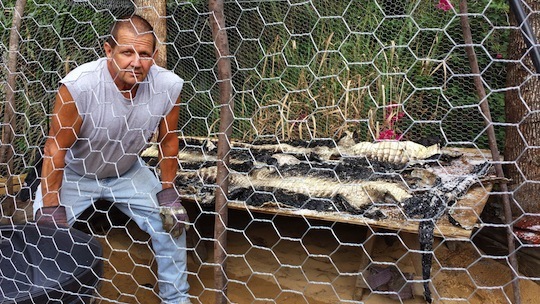
My mom says that the backyard is beginning to look like an Indian reservation – between the huge boat hull he buried in the sand to hold topsoil for gardening, to the large “gator coop” he put up to tan the gator hides in and keep the birds out, to the ducks that are laying their eggs all over the back yard. Along with bamboo growing in tractor tires, newly planted citrus trees, an archery range, a knife-throwing area, a fire pit for grilling (along with a couple charcoal grills, a gas grill, and a smoker made out of an oil drum) and more, he has really embraced the Primal lifestyle!!
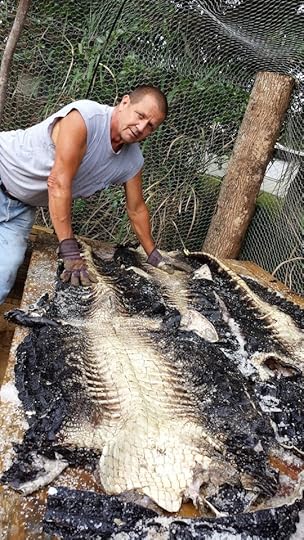
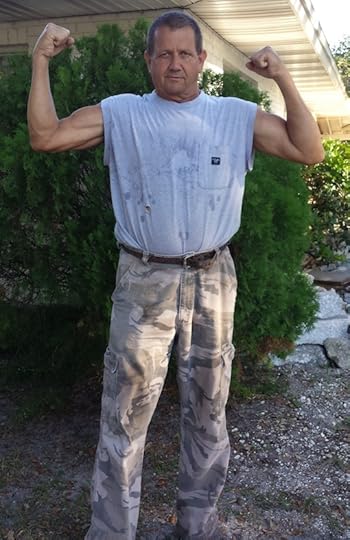
We’re so very appreciative of Mark and Mark’s Daily Apple for the limitless amount of information and resources available at our fingertips. The things we’ve learned in the past few years have literally changed all our lives, and I know that it has added years and years of quality, vibrant life to my dad and mom. I couldn’t be more grateful.
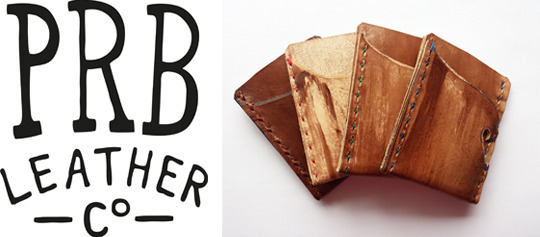
If you’re interested in supporting PRB Leather Co as we get off the ground, we’re running a Kickstarter fundraising campaign right now and we sure would appreciate it if you could help spread the word. If this really takes off, my dad can stop traveling altogether and really focus on this Primal lifestyle that he’s continuing to develop. The campaign is offering some really sweet leather wallets as rewards, and once the business really gets rolling we’ll be able to offer custom belts, different size wallets, gun holsters, knife sheaths, bow and arrow quivers, and more, and then we’ll really be able to put these gator skins to good use! The campaign runs through November 17 and we should have everything shipped out in time for the holidays.
Please check it out at: Kickstarter – Minimalist Wallets by PRB Leather Co
Thanks again to Mark, the Worker Bees, and the entire Primal community! We’re so happy to be a part of it all!
Carrie
Get the 7-Day Course on the Primal Blueprint Fundamentals for Lifelong Health Delivered to Your Inbox for FREE

November 7, 2013
A Beginner’s Guide: Why You Should Practice Meditation and How to Get Started
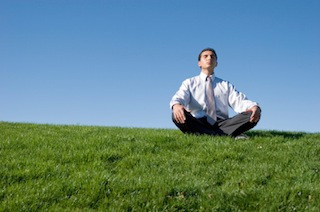 In response to last week’s “Rethinking Stress” article, a number of readers noted the relevancy of meditation to the insight. Meditation, of course, isn’t something that changes our outer circumstances. It’s an inside job, so to speak. It can change our processing of stress by shifting our relationship to ourselves and to our own cognitive responses and emotional patterns. The result? We over time come to view our own reactions and feelings from a more grounded distance. We learn to observe our emotions instead of letting them run the show. We learn, in essence, to talk ourselves down from our own trees.
In response to last week’s “Rethinking Stress” article, a number of readers noted the relevancy of meditation to the insight. Meditation, of course, isn’t something that changes our outer circumstances. It’s an inside job, so to speak. It can change our processing of stress by shifting our relationship to ourselves and to our own cognitive responses and emotional patterns. The result? We over time come to view our own reactions and feelings from a more grounded distance. We learn to observe our emotions instead of letting them run the show. We learn, in essence, to talk ourselves down from our own trees.
Meditation can seem like such a lofty thing, but it doesn’t need to. Anyone can do it, and everyone can benefit. So today I’d like explore meditation; the health benefits it confers, how it may fit into an ancestral framework, and how to get started. Let’s jump right in.
Fancy pillows and various techniques aside, the crux of meditation is this: being present. Fittingly enough, that’s pretty well in keeping with one of the 10 Habits of Highly Successful Hunter-Gatherers. The modern disconnect, I’ve said, is rampant distraction. This isn’t just about smart phones and media screens everywhere. It’s about what goes on in our own minds – all the mental blah, blah, blah that taxes our brains and frays our nerves. When you consider meditation as a spiritual practice in one regard or another, being present is meant to reclaim our own “spirit” – the self or deeper humanity that exists behind the barrage of biographical happenstance, cultural identifiers and ongoing story lines. It can be a real trip to peek behind that, let alone throw the curtain aside. What you feel is something so essential and simple you can feel like you’ve come home. The experience, you could say, is the ultimate slap in the face to Facebook cultivation and all the other individualistic stylization we participate in/attempt to dodge in modern daily life. Maybe that’s why it feels so comfortably Primal.
Benefits to Body and Brain
As with all things good and Primal, meditation isn’t just a good idea in theory. Research has demonstrated time and again that a regular meditation practice imparts striking changes to our physiological functioning and even our brain structure. Several studies have shown that meditation can lower blood pressure and reduce the activation of certain brain regions associated with worrying and anxiety. Likewise, meditation over time thickens the brain and increases the connectivity within the brain. Insular gyrification (the folding of the brain’s cortex), the researchers found, increased with added years of meditation practice. Associated with these structural changes are benefits like faster processing, better memory formation, and more integrated decision making.
Plus, there’s my personal favorite. Yes, all you epigenetic junkies out there, this one’s for you. A recent study examines the epigenetic profiles of those who received eight weeks of meditation instruction and practice. In less than two months, meditation was enough to upregulate several genes related to “energy metabolism, mitochondrial function, insulin secretion and telomere maintenance.” Likewise, genes related to inflammation and the body’s stress response were downregulated.
Primal Sense and Modern Context
With all these great physical bonuses, our ancestors must have meditated, right? It would only make sense – by evolutionary logic – that an activity this rewarding played a role somewhere, no? While hunter-gatherer societies certainly experimented with altered states, there’s no real evidence that formal meditation as we see it today had any part in human cultural activities more than a few thousand years ago.
That said, let’s break it down further. When we get to the bones of it and examine meditation as a practice for staying present, we’re onto the real Primal trail. There’s the necessity of being in the moment for survival sake. More than that perhaps is the nondirective attention of meditation. In contrast to the focused ruminating and analyzing we often engage in (directed attention), the casual, detached observation inherent to the nondirective meditation experience, so to speak, is akin to the nondirective attention we experience when outdoors. Sure, we can bring our mental chatter to the most beautiful trail hike, but what does it feel like when we don’t? As Rachel and Stephen Kaplan theorized many years ago, the soft fascination we experience outdoors restores us. So, in a sense, does the “soft” observation we cultivate in meditation practice.
Beginning a Primal Meditative Practice
Okay, so maybe you’re convinced. But where’s the time? How do I make this happen without becoming deranged by the random itches and distractions that inevitably creep up whenever I sit down to “quiet” myself?
First off, let me say that I’m no guru. Let’s just say it doesn’t come naturally to me. But, influenced by my wife, I have picked up a few things over the years, and do have enough experience to feel comfortable offering up some advice.
To start, set a low threshold goal. Don’t expect to do an hour “sit” in at the beginning. Longer times yield deeper peace, sure. It’s not for everybody, however, and that goes double for beginners. Remember, small wins… Carve out as much time as you can – when you can. Even if it’s only ten minutes, make them ten solid minutes. Once you begin to feel the benefits, you’ll likely prioritize meditation in a new way and create more time for it. Think of it this way: meditation can allow you greater peace, concentration and sleep. This all means you can be more efficient. Just those gains alone will bestow upon you the extra time to invest in your practice. Kinda like exercise, no?
While you likely can’t make it to the local meditation center every day, consider trying a weekly group practice to develop the discipline. You’ll learn a great deal from the instruction and just absorb the good energy of a group sit. (Yup, there’s something there, however woo, woo it sounds. I wouldn’t label it anything mystical. Call it community.) Plus, it’s human nature to understand we’re more likely to stick with the sit if we’re in a group. No one wants to be the jerk who got up in the middle of the session or who makes a ton of noise scooting around. We’re on our best behavior with our fellow cavefolk. With time, that behavior sets in as the “normal” default come meditation time. From there, we can transfer the discipline to our home practice.
Use the power of habit to your advantage. After you’ve attended a a group setting for a while, when the teacher says, “Prepare to receive the bell,” you can begin to slip under in the same way Pavlov’s dog began salivating. You will associate the space, the cushion, the set up, the bell, the time of day and any other salient details with the meditative relaxation response. Create the same associations at home by trying to practice at the same time of day or in the same space for a while at least. Make a calming space in your home or yard. It doesn’t have to be anything fancy – no specialty catalog shopping required. That said, once you’ve gotten the hang of it, there’s no need to save meditation for home or your nearest Zen center. I know a bike courier who needs to hang around downtown all day and finds spots in local parks for some meditation time each afternoon.
As for technique, start simple. Sit up straight on a folded blanket or comfortable pillow. Use a chair if you prefer, or even lay on the floor if you think you can stay awake.
You’ve likely often heard to focus on the in and out breath. Do it. Don’t try to manipulate the breath or do it any special way other than breathe into the abdomen. Otherwise, just follow it. Do this alone for a few minutes to try and empty the mind. Notice thoughts come and go. If one starts to take hold, release it without self-judgment. Notice your body’s sensations. Feel where the tension is bound up. Release it progressively, using the breath as a center point and rhythm for the release if it’s helpful. The concept here is to let go of all you can – mentally and physically. With practice, you may not need to focus on the breath. You’ll be able to come back to that clear, silent awareness, but the breath can always recenter you. Again, group instruction or even a good CD recording that allows some instruction time with some silence can be helpful for many people.
Other techniques assume the ability to get beyond the restlessness of the moment and focus more on emotional distance and equanimity. If you’re up for it, bring an “intention” to a particular sit. You’re not there to pull anything apart cognitively. Just present the intention and let it go. The process is still about getting underneath the mental chatter, letting the scripts of our feelings fall away and sitting with the “raw energy,” as Tibetan Buddhist nun Pema Chodron (among others) explains. With time we can learn to more casually observe the emotional energy and how it feels in our bodies.
Meditation, when we give ourselves time to explore it, can be a progressive means to getting out of our modern hyper-rational minds and letting something deeper, more instinctually and solidly Primal fill the space. In meditation, we let ourselves dwell there for a short time, but the experience can dramatically change what we bring back to daily living.
Thanks for reading, everyone. Hands – meditators? What’s been your experience with meditation, and how do you see it in relation to your Primal living?
Like This Blog Post? Subscribe to the Mark's Daily Apple Newsletter and Get 10 eBooks and More Delivered to Your Inbox for FREE

November 6, 2013
How to Manufacture the Best Night of Sleep in Your Life
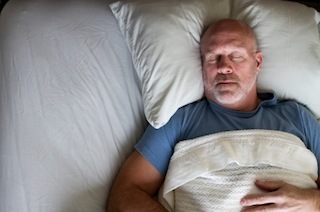 Ah, sleep: is there anything quite like it? So easily discarded and discounted when nighttime attractions present themselves and yet so dearly missed and pined after the next morning. You’ve heard me say it enough, so I’ll keep it short. A good night’s sleep is the foundation for a healthy, happy, productive existence. Good sleep keeps us lean and thinking clearly. And without good, regular sleep, we just go through life in a scattered daze, everything foggy, slightly confusing, and less enjoyable. We’re not really ourselves if we haven’t slept. We desperately need a good night’s sleep, every night.
Ah, sleep: is there anything quite like it? So easily discarded and discounted when nighttime attractions present themselves and yet so dearly missed and pined after the next morning. You’ve heard me say it enough, so I’ll keep it short. A good night’s sleep is the foundation for a healthy, happy, productive existence. Good sleep keeps us lean and thinking clearly. And without good, regular sleep, we just go through life in a scattered daze, everything foggy, slightly confusing, and less enjoyable. We’re not really ourselves if we haven’t slept. We desperately need a good night’s sleep, every night.
So how do you get one? What would a day of optimal sleep promotion look like?
Let’s start from the beginning. Let’s start with the morning.
Early Morning
Use a dawn simulator alarm clock. These are alarms with lamps that slowly and gradually brighten as your wake time approaches. It’s not the same as having the majestic sunrise beam into your room and very soul, but these contraptions have been shown to improve sleep quality. Another advantage: waking up won’t be so jarring.
When you wake up, get up. Do not hit snooze, sleep for five minutes, hit it again, sleep for five more, and keep doing that until you can will yourself to rise and stumble off to begin your day. You may think you’re effectively chipping away at sleep debt with those little bits and pieces of “sleep,” but you’re really just fragmenting your sleep (PDF), which leads to “sleepiness-related daytime impairment,” compulsory afternoon caffeine infusions, and less productivity. If you hit snooze today, you’ll probably end up sleeping badly enough to have to hit it again tomorrow.
Upon getting up, you expose yourself to bright light. Ideally, this is the sun. If it’s still dark out, you can use the brightest artificial light you have. 10,000 lux lamps are best (and in fact are used to effectively treat Seasonal Affective Disorder), but anything is better than no light at all. Our bodies, brains, and biological clocks expect bright light during the day, and meeting those expectations has been shown to improve sleep (as well as alertness and productivity during the day), even if the light is artificial.
Before “the day” starts, you get some physical activity. Go for a short walk (great way to get some light, too!) with the dog, do a light stretching or movement routine for five minutes, have sex, dance to your morning playlist as you get ready for work, roughhouse with your kids, swing a light kettlebell for a few minutes, read your email on the treadmill, ride your bike around the block, whatever. You don’t even have to work up a sweat or anything if you don’t want to. Just move a little. There’s some evidence (albeit uneven) that morning activity can improve sleep later on that night.
Brew your coffee, tea, or legal stimulant-containing beverage now if you’re going to have any today. Caffeine has a half life of up to six hours, so having that Americano after lunch could disrupt your sleep tonight.
If you eat breakfast, eat a good portion of animal. Meat (and not just turkey) is a good source of the amino acid tryptophan, and high-tryptophan breakfasts have been shown to improve sleep quality. Steak, eggs, and whey protein, anyone?
If you don’t typically eat breakfast, you probably don’t need to start. Intermittent fasting can also improve sleep. If your sleep is suffering, you might want to try the meat breakfast, though.
Mid-Morning
Work hard, be proactive, and stay focused. Getting as much work done as you can before noon will take the mental load off the rest of your day, allowing you to relax a bit. Procrastination will only make you stressed out, and stress is the enemy of good sleep.
While you’re working, take a minute to install f.lux on your computer. F.lux is a free program that changes your computer’s color spectrum automatically according to the time of day. When it’s dark out, an f.lux-enabled computer gives off very little sleep-disrupting blue light.
Last call for caffeine. If you do go for coffee, grab a cup of good green tea to go with it; green tea contains L-theanine, which can partially counteract the sleep disturbances caused by caffeine. Primal Calm also contains L-theanine, as well as other stress-modulating ingredients, so that’s another option.
Midday
Sometime after lunch, meditate for twenty minutes. Several studies have shown that meditation practice can improve sleep, including cyclic meditation (a kind of yoga-meditation fusion) and mindfulness meditation. There’s even evidence that meditation can decrease the amount of sleep you need to function.
When and if you nap, do it closer to midday than to your bedtime. A nap taken too close to nighttime can interfere with your sleep.
Go for a barefoot stroll in the grass, dirt, sand, or the natural surface of your choice. Even a quick walk on the lawn outside the office works. Though earthing is controversial, its proponents may be overstating its benefits, and the studies connecting it to better sleep may not be the best-designed, who doesn’t feel better and more relaxed after letting the leaves of grass trace their way between your toes, feeling the cool damp earth underneath, or tromping an uneven unsteady path through soft white sand? It certainly doesn’t hurt.
Early Evening
If you plan on drinking, do so around this time. Alcohol too close to bed – even just a couple glasses of wine – can impact sleep. You’ll sleep, but it’ll be poor quality sleep fraught with frequent disturbances. This validates both happy hours and day drinking, in a way.
Eat most of your carbs at dinner. A recent study showed that eating carbs, even high-glycemic ones, at the last meal shortened the sleep onset. In other words, packing your carbs into dinner can help you fall asleep faster.
Eat animal fat and/or olive oil at dinner (and lunch, and breakfast). Both animal fat like lard or beef fat and olive oil (or macadamia nuts, for that matter) are excellent sources of oleic acid, a precursor to the sleep-inducing oleamide.
Dim the lights when darkness falls. If it’s dark outside, your body needs to start winding down, and excessive artificial lighting will get in the way of that.
Turn off the screens an hour or two before bed. Smartphones, laptops, computers, TVs, tablets – they all emit melatonin-disrupting blue light directly into our staring, transfixed eyeballs. If you miss the entertainment factor, play board games. Heck, start a board game night and invite people over.
Use blue blocking goggles after dark. These, coupled with the f.lux you installed earlier, should block out the harmful blue light when you need (or “need”) to use electronics. I like this pair, while this pair fits over glasses.
Bedtime
Drink some bone broth, eat some gelatin, or take glycine. All of those things either contain or are glycine, an amino acid with sleep promoting effects.
Clear your mind. Meditation can work here, again, or you could make a to-do list for the following day so that you don’t lie awake obsessing over everything.
Rub your body down with magnesium oil or lotion. I go for the softest areas, like under my arms or along my rib cage. If it stings, you know it’s working. Bonus: it gives you (or me, at least) really cool, really vivid dreams. Some people are paradoxical responders who actually sleep worse on this stuff, just so you’re aware.
Read some dense fiction in bed, in actual physical book form (nothing against ebooks at any other time, but they represent a light source that can disrupt sleep). Don’t read easily digestible stuff like an old John le Carre spy novel. Instead, go for something like Cormac McCarthy’s Blood Meridian that has you parsing paragraph-long sentences. Great book, but you’ll be asleep in no time.
Eliminate, remove, or cover up any sources of light in your bedroom, even the tiny blinking ones. Black-out blinds over your windows, duct tape over your blinking lights, and towels under doors may be warranted to achieve true darkness.
Use white/brown noise or nature sounds before bed. Falling rain is a good sound to fall asleep to, as are the somewhat haunting but eerily beautiful whale songs.
Guided meditation can help you get to sleep. Search iTunes for “guided meditation” and a bunch of podcasts will pop up. Just don your blue blocking goggles before using your phone to play one.
Take a tablespoon of honey, preferably raw, right before bed. Seth Roberts has shown through rigorous self-experimentation how it might very well improve sleep, perhaps by keeping liver glycogen full.
Middle of the Night
Improve your aim and reduce your reliance on lights. If you get up in the night to urinate, don’t flip on every light as you pass them. Most people can adjust to the darkness if they let themselves.
Don’t check your email just because you woke up. It’s not that important (if it were, they’d call), and whatever you read is only going to keep you up. Also, blue light!
General Advice
Make sure to eat enough salt throughout the day, since a depletion of bodily sodium stores can trigger overtraining-like symptoms, raise blood pressure, and impair the quality of your sleep. I won’t give an absolute amount, because that will differ based on size, activity level, stress, and many other factors. Just salt your food until it tastes good. So much for total salt avoidance, eh?
Exercise regularly. Regular exercisers report getting better sleep than people who don’t exercise at all, even on the same number of hours. In people with sleep disorders like insomnia, exercise can make things worse in the short term or have no effect at all. Working out once probably won’t help once. It’s over the long term (4 months) that exercise can improve sleep quality in insomnia patients. Exercise also increases sleep quality in sleep apnea patients.
Exercising at night is generally fine. Get it in whenever you can fit it. However, really intense pulse-pounding glycolytic work an hour before bed (like Crossfit or HIIT) might impact your sleep onset, simply because your cortisol is momentarily elevated. Proper cool downs should help get you back to baseline, as should food and a cold shower.
Align your life schedule with your chronotype. This isn’t possible for everyone to do perfectly – we all have to pay the bills, and that often means working on someone else’s schedule – but even small strides in the general direction of our genetic chronotype can help.
Obviously, not everyone needs to do or try every suggestion on here. I just combed through the research and put everything out on the table so you could pick and choose and experiment to see what works and what doesn’t. We’re all different.
Thanks for reading, everyone. Let me know what works for you and what does not work. I can always use better sleep, so I’ll definitely be keeping an eye out for new tips.
Like This Blog Post? Subscribe to the Mark's Daily Apple Newsletter and Get 10 eBooks and More Delivered to Your Inbox for FREE

November 5, 2013
Chronotypes: Are You an Early Bird or a Night Owl?
 Are you a morning person or a night owl?
Are you a morning person or a night owl?
Longtime readers of this blog would likely say that the answer to that question depends on several factors: how much light exposure you get during the day, how much light exposure you get at night, how your cortisol fluctuates throughout the day, how much coffee you drink and when you drink it, or what time you go to sleep. The best part is that they’re all modifiable. By changing them, we can change how we feel in the morning, how productive we are at certain hours, and whether we need that extra cup of coffee in the afternoon. We are not at the mercy of powers unbeknownst to us. We hold the power.
But is that the whole story?
Probably not. A growing body of research has identified something called a chronotype: a sleep phenotype, determined by slight alterations to the “Period 1″ gene, that influences your sleep and wake time. Genetic early birds have an AA nucleotide base and will be naturally inclined to go to bed and wake up earlier. They make up roughly a third of the population. 16% of people are genetic night owls with a GG nucleotide base; they tend to have later bedtimes and wake times (about an hour after the early birds). And the middle ground – which is almost 50% of people – have an AG base and a tendency to wake up “between” the two extremes. You can affect your sleep habits by changing things like light exposure at day/night, electronic media consumption, caffeine intake, and so on, but the genetic chronotype will always underline your response. It’s the baseline, and recent evidence in live humans confirms this.
You know how when we mention epigenetics, we usually refer to modifiable environmental factors affecting gene expression? The food we eat, the exercise we get, the thoughts we think, the stressors we encounter – these can all modify the function of our genes and we in turn can modify our exposure to them. But here, it’s the actual genetic chronotype that’s affecting how our genes express. It appears that the genes regulating sleep cycles are being modified by the chronotype itself, a kind of internal, self-contained epigenetic input that we cannot directly or consciously alter. Some might see that as a loss of power in determining our fate, but I think it’s a really interesting concept, an additional wrinkle to the broadening story of gene expression.
What does this mean for your health?
Well, mornings tend to be tough for folks with the night owl chronotype. That’s to be expected, since going to bed later than society expects while having to wake up earlier than your biology “wants” means inadequate, lower quality sleep. We all know how a night of poor sleep feels. Imagine a lifetime!
But that’s not all. A quick trip through the literature reveals numerous connections between the night owl chronotype and poor health outcomes. It all seems quite dire:
In type 2 diabetics, having a night owl chronotype is independently associated with poor glycemic control. Shift workers were excluded from the study so as not to confound the results.
Among fibromyalgia sufferers, night owl chronotypes are more affected by the syndrome than other chronotypes.
Night owls tend to eat unhealthy food, have more sleep apnea, and secrete more stress hormones.
”Evening types” (does this sound derogatory to anyone else?) are more likely to be depressed than other chronotypes.
Why would a chronotype that confers a higher risk of just about every negative health malady be selected for by evolution? How did the GG nucleotide even survive?
Because it’s only in a society with a standard universal workday that begins at around 8 AM that the night owl is an unhealthy, lazy malcontent worthy of our disdain. For every one of the “negative health effects of being a night owl chronotype,” I can link it directly to a lack of sleep:
Poor glucose tolerance? A lack of sleep will lead to it.
Fibromyalgia? Strongly linked to a lack of sleep.
Unhealthy eating? A bad night’s sleep makes junk food more enticing.
Prone to depression? Bad sleep could be causing it.
Thousand of years ago, the night owl would have been the lookout man, the nighttime raider, the drummer around the fire, the shaman who stayed up all night accepting patients. He would have been privy to the same ancestral environmental cues as everyone else – daylight, absence of light at nighttime, whole real foods, plenty of vitamin D – but his chronotype would have pushed his bedtime back a bit and he wouldn’t have been any worse for wear. He didn’t have to get up to beat rush hour or satisfy society’s arbitrary notion of a workday schedule. He could sleep in; he wasn’t getting fired or evicted or forced to get inadequate sleep just to satisfy society’s expectations.
The early bird had a role, too, of course. He’d get up at dawn, or just before it, to get a jump on the game. To stake out a good spot at the watering hole or the feeding grounds.
They are genetic outliers, but we need outliers. The tribe with a blend of early birds, night owls, and in-betweeners would have a better shot at surviving and thriving than the tribe with a perpetual case of the Mondays or the tribe who just can’t stop yawning after dark with the lookouts who fall asleep at their posts.
Nowadays, late chronotypes often suffer from social jetlag: an often permanent misalignment between the demands of their biological clock and the expectations of society. This misalignment even shows up in MRI scans, with night owls having malfunctioning white matter in the “sadness” and “depression” areas of the brain. “The world” assumes an early chronotype. Early risers get the accolades, the job offers. Work schedules revolve around early risers.
It’s no wonder that late chronotypes have all sorts of negative health effects normally associated with poor sleep – they live in a society that forces them to go to bed earlier than they want and wake up earlier than they’re meant to! Social expectations conspire against them.
How can you tell what chronotype you have?
To determine a person’s chronotype, researchers use a standardized questionnaire that you can access online for free. It’s widely considered to be just as accurate as the genetic tests, so anyone who’s wondering about their own genetic chronotype should go on and take it.
There’s also a cheek swab that will determine your genetic chronotype, but it’s not widely available to the public so I wouldn’t count on it.
What should you do if you’re a late chronotype?
Avoid substance abuse. One study found increased psychological distress (depression, sadness, etc.) only among late chronotypes who smoked and drank to excess. While this doesn’t necessarily suggest a causal relationship – it could very well be that only those under psychological distress seek solace in substance abuse – avoiding excessive tobacco and alcohol is a good policy regardless.
Send your boss a link to this post. Make it known that it’s in your employer’s best interest that you’re able to adhere to your biological clock. You’ll be healthier, more productive, and more alert. Everyone wins. It’s not even that you need to sleep in until noon. Just an extra hour in the morning will make a huge difference. Of course, if this works, make sure you get to bed at a reasonable – for you – time. Don’t use this as an excuse to stay up even later.
Become your own boss. This won’t work for everyone, but I know a sizable portion of my readers have wanted to do their own thing for a long time. I’d even say it’s a common, population-wide desire that most people simply don’t act on. Well, let this be the start of something beautiful. Your health and happiness (and productivity) may depend on it. Perhaps that’s one reason entrepreneurs are happiest, regardless of socioeconomic status – they set their own schedules. A night owl entrepreneur can operate according to his or her biological, genetically-determined clock.
Follow best sleep practices – limit extraneous artificial light and electronic media after dark, get plenty of natural light during the day. You may have a different baseline, but blue light will still push your sleep cycle back, a lack of natural light during the day will still disrupt your sleep, and your social jetlag will get even worse.
Take heart, night owls. It’s not so bad. Your genes are the stuff of fierce warriors in the night, of stalwart sentries keeping watch over their people, keeping them safe, of wild-eyed shamans bridging the gap between this world and the next. You are dreamers and artists and comedians and inventors and entrepreneurs. If you’re a night owl who’s suffering for it, I suggest you embrace your heritage and find a way off your current trajectory that simply isn’t working for you.
It sounds daunting, doesn’t it? But it’s probably really important.
Good luck!
What about you, folks? What kind of a chronotype do you have? Did you take the quiz? Do so and report back; let us know if the results jibe with your experiences!
Thanks for reading. Take care.
Get Your Omega-3s: Order Two Bottles of Primal Blueprint Fish Oil Capsules and Get An Additional Bottle Absolutely FREE

Mark Sisson's Blog
- Mark Sisson's profile
- 199 followers




